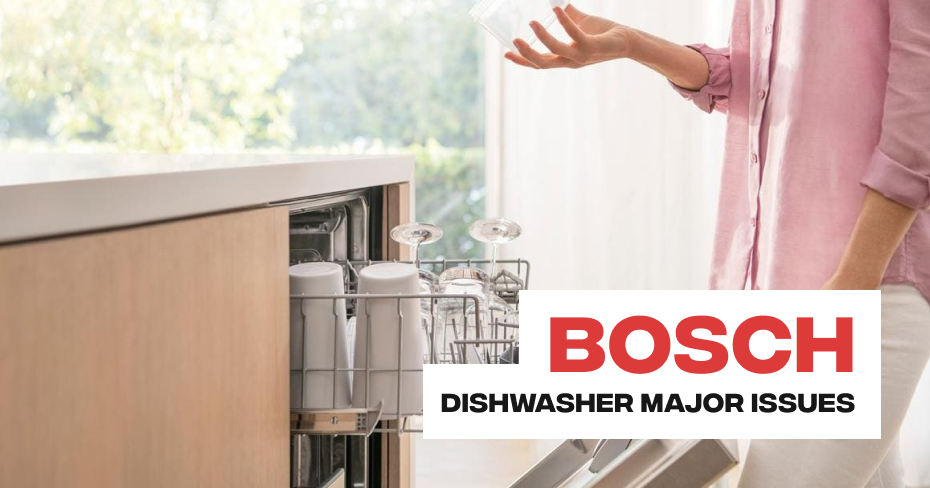
Dishwasher Not Draining
The most common cause of a Bosch dishwasher not draining properly is a blockage, so check your filter to see if there is food residue that is causing an obstruction. The second most typical reason a Bosch dishwasher stops draining is if either the filter or water pump is clogged with food debris. This guide will show you exactly how to check and clean these components.
Blocked filter unit
One of the main reasons your Bosch dishwasher may not be draining properly is that the filter unit is blocked. The filter prevents food particles from depositing back onto clean dishes and clogging drains. As water and dishwashing liquid circulate through the dishwasher, bits of food are rinsed away, leaving them behind in the filter at the base of the dishwasher. Clearing the filter unit of this debris may help your dishwasher drain normally.
How to clean a filter unit
It is important to regularly clean your filter unit. If you are finding that your Bosch dishwasher is not draining, this is the best place to start.
- Remove the bottom dish rack
- Twist and remove the filter unit – a circular tube found in the base of the dishwasher
- Remove the cylinder from the filter by untwisting
- Wash both the cylinder and filter using a small brush to remove any debris
- Twist the filter back into the cylinder and then twist the unit back into the dishwasher, ensuring the arrows align
Blocked dishwasher pump
The dishwasher pump is found in the bottom of your Bosch dishwasher and is responsible for forcing water into the spray arms. It also directs the water into the drain hose during the drain cycle. If the dishwasher pump is blocked, this may cause your dishwasher to stop draining properly.
How to unblock a dishwasher pump
- Remove the bottom dish rack
- Remove the filter unit by lifting the cylindrical tube
- Remove the remaining water out of the bottom of the dishwasher using a sponge, or similar
- Using protective gloves, remove the pump cover found below the removed filter unit. This can be done by prising it off using a small spoon. The pump cover is a white, plug like plastic component and can be removed by pulling it upwards and forwards
- Clean out the pump, removing any debris that may be found
- Return the pump cover, ensuring that it clicks back into place
- Return the filter unit, making sure that the arrows align
Twisted or kinked drain hose
The drain hose is responsible for draining water during the spin cycle. The drain hose is a large pipe found connected to the dishwasher and runs underneath your sink. If the drain hose is kinked or twisted, it will no longer drain the water. Smoothing out these bends and checking for any debris can help address this issue.
You can generally pull out your dishwasher’s hose using a pair of tongs, then clean out any clogs using a commercial drain cleaner. Once you have checked for and removed any clogs in your drainage hose, you will need to reconnect it to your dishwasher.
How to straighten and clear the drain hose
- Disconnect your dishwasher from the power supply
- Start feeling along the drain hose for any sharp bends or kinks, straightening them out as you go
- Carefully disconnect the drain hose (being aware that hot water will likely drain from the pipe) and place the disconnected end into a bucket
- Feel for any blockages that may be stopping the flow of water
- If needed, fully disconnect the drain hose and run water through it to clean it thoroughly
- Reconnect the pipe and run the dishwasher on a quick cycle to test whether the pipe is draining
Blocked drain lines
If you have a garbage disposal, run it; this may occasionally clear the back-up debris from your drain lines, allowing the water to flow out of the dishwasher. Since debris is often stuck in your drain, try cleaning it using a solution of equal parts baking soda and vinegar.
Mix together about a cup of each baking soda and vinegar, then pour the mixture in the standing water in the lower portion of your dishwasher. Run the hot wash cycle with vinegar in a standing cup in it, and then follow that up by dumping an equal amount of vinegar and baking soda–one cup each–into the bottom of the dishwasher. If a pool of water is sitting at the bottom of the dishwasher once the cycle is over, then you probably have a drainage problem caused by a blockage somewhere in your filter or in the tub.
Preventing blockages
A dishwasher that is clogged or overflowing could result in serious water damage in your home if it is not taken care of. A clogged dishwasher causes these problems because it cannot drain as well and water does not pass through it the way it is supposed to.
Some simple ways to prevent blockages that may cause your Bosch dishwasher to stop draining include:
- Scraping food scraps off dishes before placing them in the dishwasher
- Running your dishwasher on empty, with white vinegar once a month to clear out any blockages
- Run your dishwasher using the hot water cycle, as cold water will not break down deposits as efficiently
- Periodically clean out the filter, even if your dishwasher is draining properly
